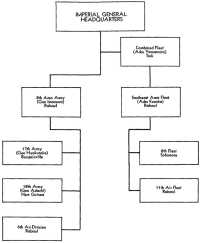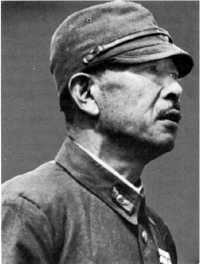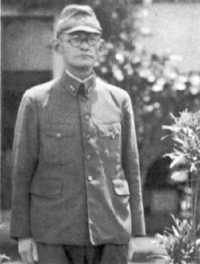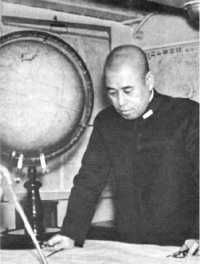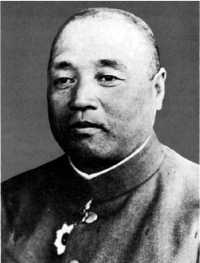Chapter 17: Japanese and American Plans
The blow, wherever struck, must, to be successful, be sudden and heavy.—GENERAL ROBERT E. LEE
In late November 1942, when the tide of battle in the southern Solomons and the Papuan Peninsula turned in favor of the Allies, the Joint Chiefs of Staff in Washington and the American commanders in the South and Southwest Pacific began to consider once more how best to continue the offensive against Rabaul. The offensive inaugurated by the Joint Chiefs’ directive of 2 July 1942, it will be recalled, consisted of three tasks. The first of these, the seizure of Guadalcanal and Tulagi, was now almost completed. With its completion and the seizure of Buna the Allies would have forward bases in the Solomons and New Guinea from which to launch the operations required by Tasks Two and Three: the conquest of the remainder of the Solomons, of the northeast coast of New Guinea, and, finally, of New Ireland and New Britain in the Bismarck Archipelago. It was essential, if the impetus of the Allied drive was to be maintained, that plans for the execution of these two tasks be made quickly. The Japanese would not stand idly by if the Allies did not follow up their advantage. Already they were making plans of their own.
The Japanese Regroup
Although the mid-November air and naval battles virtually assured an Allied victory on Guadalcanal, the Japanese were not yet ready to admit defeat. With a full recognition of the seriousness of their situation in the Solomons and New Guinea—which together they designated as the Southeast Area—the Japanese made preparations to recoup their losses and to repulse any further Allied offensives. Their first step was to establish on 18 November a more effective command in the area. The 17th Army, which had hitherto been responsible for operations in the Solomons and New Guinea, was restricted by order of Imperial General Headquarters to the Solomons alone. At the same time a new headquarters, 18th Army, was established for operations in New Guinea, with Lt. Gen. Hatazo Adachi, chief of staff of the North China Area Army, in command. In addition, the 8th Area Army, a theater command comprising the two armies, was created, and Lt. Gen. Hitoshi Imamura, commander in Java, was ordered to Rabaul to take over the new post. These arrangements, which the
Navy paralleled by placing the 11th Air Fleet and the 8th Fleet under a Southeast Area Fleet, were to go into effect on 26 November.1
Orders from Tokyo to Imamura and to Admiral Yamamoto, commander of the Combined Fleet at Truk, made it clear that the high command was determined to maintain and reinforce the Japanese position in the Southeast Area. In the Solomons, both commanders were instructed to strengthen air bases and intensify air operations against Allied shipping and ground forces. At the same time they were to reinforce the troops on Guadalcanal who would meanwhile “secure key positions in preparation for offensive operations, while recovering their strength.”2 Once these measures had been completed, then the Army and Navy commanders would unite their forces in a joint offensive to retake Henderson Field, Tulagi, and other key positions in the Solomons.
The program Imperial General Headquarters laid out for its forces in New Guinea was as ambitious as its plans for the Solomons. Buna, which had not yet been taken by MacArthur, was to be strengthened, as were the bases at Lae and Salamaua. In addition, Japanese forces were to occupy Madang, Wewak, and other unspecified strategic areas in New Guinea. “Preparations for future operations ... ,” decreed the high command, “will embrace every possible plan for the capture of Port Moresby. ...”3 (Chart 6)
To carry out these tasks, Imperial General Headquarters gave to Imamura strong ground and air reinforcements. The former included three divisions and as many brigades. Air reinforcements consisted of the 12th Air Brigade and the 76th Squadron, which, with air units already in the area, were placed under the newly established 6th Air Division to provide support for both the 17th and 18th Armies. On activation late in November, the air division had fifty-four light bombers, eighty-four fighters, and some reconnaissance planes, but it did not begin active operations until a month later.
After a hasty journey by air from Tokyo via Truk, where he conferred with Admiral Yamamoto, General Imamura reached Rabaul on 22 November 1942, just a few days before Adachi, the 18th Army commander, arrived from China. On the 26th, Imamura formally assumed command of the 8th Area Army, established his headquarters, and issued his first directive governing operations of the two armies under him. Based on the Imperial General Headquarters order of 18 November, this directive required the 17th Army to recapture Guadalcanal and the 18th, in cooperation with naval forces, to hold and consolidate its position at Buna while preparing for future operations, presumably against Port Moresby. Operations in the Solomons were given first priority and for this purpose Imamura assigned his main strength to the Guadalcanal operation, which would begin about the middle of January. With these orders went a message
Chart 6—Organization of Japanese Forces, Solomons–New Guinea Area, January 1943
Source: Southeast Area Operations, pt. IV, Japanese Studies in World War II, 127, pp. 12-14; Imperial Japanese Navy Organization, Japanese Studies in World War II, 116.
of sympathy for those who had survived the “hard and painful battle” and an injunction to the officers and men, whose bravery was “enough to make even the gods weep,” to “set His Majesty’s heart at ease” by winning through to victory.4
These orders for offensive operations, issued at a time when Allied air and naval forces had gained control in the battle area and when Allied ground forces had seized the initiative and were pressing the Japanese on every side, proved entirely unrealistic. Buna fell early in January, after Adachi had ordered his troops to withdraw up the coast a short distance to Sanananda. On Guadalcanal, where the American Division commander, General Patch, had assumed control of operations on 9 December, the Americans were already making plans for a final offensive. The signs of a Japanese defeat were too clear to be ignored even by the optimistic planners in Tokyo, and at the end of December, scarcely more than a month after it had ordered the offensive Imperial General Headquarters decided the time had come to withdraw Japanese forces from Guadalcanal and the Buna area.5
The Japanese decision, conveyed personally to Rabaul by one of the senior Army officers in Imperial General Headquarters, reached Imamura on 4 January. Immediately he made plans for the evacuation of those troops that could still be saved and during the next few weeks Japanese destroyers under cover of darkness brought out large numbers of men from Guadalcanal undetected. On 23 January MacArthur announced that the campaign for Papua was over, and on 9 February General Patch made a similar announcement for Guadalcanal. Thus ended the 6-month campaign to halt the Japanese drive toward Port Moresby and the South Pacific. The Allied line of communications to Australia and New Zealand was finally secure.
The decision to withdraw from Guadalcanal and Buna did not signify that the Japanese intended to abandon the Solomons and New Guinea. It emphasized rather their determination to retain their hold in the Southeast Area and was the prelude to a regrouping of forces and the strengthening of defenses. “Hereafter,” read the 4 January order from Imperial General Headquarters, “the Bismarck Archipelago and the Solomons Islands north of New Georgia and Santa Isabel will be secured ... , operational bases such as Lae, Salamaua, Madang and Wewak will be strengthened at once and strategic points north of the Owen Stanley Range in northeast New Guinea will be occupied and secured.”6
Even before he received these instructions, General Imamura had begun to strengthen his position in the Southeast Area. His orders when he assumed command had called for such a program, and one of his first official acts had been to initiate plans for the occupation of Madang and Wewak. This task he had assigned to the 28th Army, and General Adachi had occupied both places in mid-December with three infantry battalions recently arrived from the Netherlands Indies. Work on airstrips and roads began immediately. About the same time a special naval landing force moved
General Adachi
General Hyakutake
into Finschhafen, off the tip of the Huon Peninsula, opposite New Britain.
The garrisons at Lae and Salamaua were reinforced early in January by the Okabe Detachment, a reinforced regiment of the 51st Division stationed at Rabaul. It was Adachi’s plan to bring the entire division to Lae, where he planned to establish his headquarters, and to put the 20th and 41st Divisions at Madang and Wewak, thus making both areas strong enough to meet the expected Allied attack. The plan went awry, however, thanks largely to the activity of Allied bombers. The convoy carrying the 51st Division was attacked and almost destroyed by Kenney’s Allied Air Forces in the Battle of the Bismarck Sea between 1 and 3 March, and the division virtually annihilated. Adachi did succeed during January and February in putting ashore at Wewak the bulk of the 20th and 41st Divisions. But so effective was the Allied air blockade that the Japanese had to make their way by land and small boats to Madang where they sought to open up a land route to the base at Lae.
Japanese defenses in the Solomons were also considerably strengthened during this period. The airfield at Munda in New Georgia, originally intended as a base from which to support operations on Guadalcanal, was completed on 15 December, when work was begun on a new airstrip at Vila on nearby Kolombangara. Other bases further up the Solomons ladder, in the Shortlands, on Bougainville, and on Buka, were strengthened and additional
Admiral Yamamoto
General Imamura
troops brought in to replace the decimated units evacuated from Guadalcanal. On Bougainville, where General Hyakutake had his 17th Army headquarters, was the 6th Division, and on New Britain was the 38th, reorganized after its experience on Guadalcanal. The three infantry battalions in New Georgia and Santa Isabel, now the most forward Japanese positions in the Solomons and by agreement between Imamura and Yamamoto an area of naval responsibility, were reinforced in February and March with naval troops and in April with two infantry regiments.
In air power, which had been so critical a factor for both sides in the campaigns just ended, the Japanese had clearly lost the lead to the Allies. During the struggle for Guadalcanal alone they had sacrificed about 900 naval planes, one-third of them carrier-based. At the end of February 1943, they had only 200 Navy and 100 Army combat aircraft of modern design, mostly Zero fighters and twin-engine land-based bombers. Three months later, after every plane that could be spared had been sent to the Southeast Area, the strength of the 6th Air Division numbered 217 aircraft—77 bombers, 114 fighters, and 26 reconnaissance planes.7 With the Navy’s 11th Air Fleet, numbering about 200 operational planes, and with the 200 carrier-based planes of the 3rd Fleet at Truk, this total represented the peak strength in aircraft of the Japanese command in the Southeast Area in
the period before the Allies resumed the offensive.
Tasks Two and Three: The Indivisibility of Strategy and Command
American planning for operations against Rabaul began almost immediately after the last threat of a successful Japanese counterattack against Guadalcanal had ended. The spark was provided by General Marshall who, on December, sent Admiral King for comment the draft of a directive for the theater commanders telling them to go ahead with Tasks Two and Three. Substantially the same as the Joint Chiefs’ directive of 2 July 1942, which had inaugurated the Allied offensive, Marshall’s draft specified that the forces required would come from those already assigned to the South and Southwest Pacific Areas, subject to the approval of the Joint Chiefs. Fully aware of Admiral King’s concern for the mobility of the fleet, Marshall also reserved to the Joint Chiefs the right to withdraw naval units in the event of an emergency. Like the original plan, this new directive gave to MacArthur strategic direction of the campaign against Rabaul during Tasks Two and Three but specified that direct control of the naval and amphibious phases of the campaign would be exercised by a naval officer. MacArthur, thus, would have the authority to select the objectives, allocate the forces, and fix the timing and sequence of the operations.8
With this proposal, Marshall precipitated anew the long-standing debate over command in the Pacific, disguised at first as a discussion of strategy. The initial reaction of the naval planners to the draft directive was favorable, but Admiral King, who had for some time been pressing for a revision of the July 1942 directive, did not give his consent so readily. He had other ideas that he thought might make Tasks Two and Three unnecessary and give to the Navy control of the offensive against Rabaul. Why continue up the Solomons and assault the Japanese bastion frontally, he asked? On the basis of the Guadalcanal experience it would take years to reach Rabaul that way. Instead, why not outflank the Japanese by seizing the Admiralties, northwest of Rabaul, and bypass the Solomons altogether?9
Nimitz and Halsey showed no enthusiasm for this idea when King put it up to them. To the former the relative merits of a frontal versus a flanking assault against Rabaul seemed academic. In his view, Task One would not be finished until air and naval bases had been established on Guadalcanal and the area firmly secured. Moreover, it was impossible to start on Task Two until Washington made larger forces available. Those in the theater were not adequate to do the job. And when the offensive was resumed it should be directed by Halsey, not MacArthur, declared Admiral Nimitz, giving as his reason the fact that since operations in the Solomons would require most of the surface forces of the Pacific Fleet, command should be vested in a flag officer. “Any change of command of those forces which Halsey has welded into a working
organization,” he told King, “would be most unwise.”10
These views Admiral Nimitz expanded in a letter to King a week later. In it he met his chief’s proposal for a flanking operation against Rabaul by way of the Admiralties with the argument that the capture of the Japanese bastion would not give the Allies control of the Solomons. The enemy’s bases there and in New Britain and New Ireland, he pointed out, were mutually supporting and there was no assurance that the seizure of Rabaul would reduce their effectiveness or induce the garrisons to surrender. Moreover, if the Japanese retained control of the straits and seas south and east of Rabaul, the Allies would only expose their flanks to attack if they bypassed the bases in that region. Thus, Nimitz concluded, the planners would have to accept a step-by-step frontal attack up the Solomons, with the next objective the Munda air base on New Georgia or Buin on the southeast coast of Bougainville. The choice would depend on the size of the force provided and the state of Japanese defenses. And again he urged that Halsey be given command of operations in the Solomons.11
In the South Pacific, both Admiral Halsey and General Harmon fully subscribed to the concept of a progressive step-by-step advance up the Solomons ladder as a prerequisite to the seizure of Rabaul. “To be able to attack the Bismarcks simultaneously from New Guinea and the Solomons,” wrote Harmon, “would be ideal.” But he did not believe that the South Pacific could do much to aid MacArthur’s advance along the northeast coast of New Guinea. “To send surface forces into the western areas of the Solomons Sea with the Jap air as heavily entrenched as it is,” he told Marshall, “would be taking a risk beyond the gain to be anticipated even with the best of fortune.”12
It was primarily to meet the danger of Japanese air attack on Allied surface forces as well as to support naval operations in the Solomons that Admiral Halsey conceived the idea of seizing Woodlark Island between New Guinea and the Solomons as the site for an air base. That island, as well as the neighboring Trobriand group, lay outside the bad weather belt. Its possession would provide the Allies with a fighter and medium bomber base site within range of Rabaul as well as a staging point for aircraft midway between the South and Southwest Pacific. Since Woodlark lay in MacArthur’s area, Halsey suggested to him in mid-December that it be seized, offering at the same time to furnish some of the troops required. Although MacArthur did not take up the suggestion then, Admiral King, who had received a copy of Halsey’s message, apparently looked on the proposal with favor and asked Halsey to consider also the possibility of taking Kiriwina and other islands in the Trobriand group. There the matter rested for the time.13
Though he was willing to shelve Admiral Halsey’s suggestion temporarily, King thought Nimitz’ ideas important enough to pass on to Marshall and
Leahy. Only Marshall’s comments are on record. The admiral, Marshall pointed out, had failed to include in his calculations the forces of the Southwest Pacific, whose air component would be “a most important factor in whatever plan is adopted.” This failure, as well as the absence of information in the War Department on Navy and Marine aircraft, observed the Army Chief of Staff, constituted “the most compelling argument against the continuance of divided command for future operations in the Solomon Islands—Bismarck Archipelago.”14
The arguments that Nimitz had presented in favor of a step-by-step advance up the Solomons under Halsey’s command Marshall used to support a unified command under General MacArthur. The Japanese positions in the Solomons and New Guinea, he pointed out, resembled an inverted V with the point at Rabaul. Against each leg of the V the Allies had placed two strong but separate forces, one controlled from MacArthur’s headquarters and the other from Nimitz’, thousands of miles away, and each independent of the other. “Skillful strategic direction, coordinating the employment of the two strong Allied forces available,” Marshall insisted, “appears mandatory to offset the Japanese advantages of position and direction.” Only in this way could the Allies exploit quickly success against either leg of the V and at the same time use their forces, especially the bombers with their strategic mobility, where they were most needed and where they could achieve the most decisive results.
With Nimitz’ contention that Admiral Halsey’s command in the South Pacific should not be disturbed, General Marshall agreed. He did not intend that it should. The plan he had in mind, he pointed out, would leave to Halsey the tactical control of his forces and would not affect the efficiency of his command. All that he wanted to do, Marshall told King, was to give MacArthur strategic control of Tasks Two and Three. Moreover, he reminded the Chief of Naval Operations, the projected operations against Rabaul would all take place in MacArthur’s Southwest Pacific Area and should therefore be under the control of the area commander.
Admiral King, who had not yet replied to Marshall’s initial proposal of t December, delayed two more weeks after receiving this new note. In the meantime the Army and Navy planners continued to discuss the matter in the hope of reaching a settlement acceptable to their chiefs. On 23 December, two days after they had received Marshall’s memorandum, the Navy planners had the draft of a reply ready. They accepted the principle of unified command without argument but expressed doubts about the advisability of turning over to MacArthur the direction of operations in the Solomons at that time. To them, command was inseparable from control of the Pacific Fleet. The Navy, they argued, could not discharge its responsibilities unless the fleet commander was free to shift his forces from one area to another as the situation changed and in accordance with naval doctrine. What the naval planners feared was the improper employment of the fleet by an
Army commander or the loss of its mobility by assignment to a limited theater of operations, a point Marshall had made in connection with the employment of bombardment aviation. “If the Pacific Fleet is seriously weakened,” they asserted, “the whole Pacific campaign will collapse. We must therefore be careful to insure that the Fleet is not so handled as to risk serious loss without commensurate damage to the enemy.”15
Though the Navy planners opposed giving to MacArthur strategic direction of the campaign against Rabaul on the terms proposed by the Army, they were willing to do it if Nimitz was appointed the supreme commander for the entire Pacific theater. Nimitz, thus, would be MacArthur’s superior and the guardian of the Navy’s interests in the Pacific. It was an offer to trade, a quid pro quo arrangement by which the naval planners offered the Army command over operations against Rabaul in return for control of the Pacific, or, as they put it, for an arrangement that would guarantee “the strategic flexibility” of the Pacific Fleet.
The Army planners refused to trade on this basis. All that Marshall had proposed, commented General Handy, was a unified command for operations already projected in the Solomons and New Guinea. That question could be settled quickly by action of the Joint Chiefs of Staff. The larger problem of command for the entire Pacific had “political, international, and organizational implications” that would make a solution much more difficult. For this reason alone Handy urged that the Navy accept Marshall’s proposal, which would not only speed up operations against Rabaul but would constitute also “a positive step toward eventual unification.”16 Nor did Handy miss the opportunity to point out that the principle of strategic flexibility applied equally to the Air Forces and that ground troops, too, played a vital role in the Pacific war. “The Fleet,” he observed tartly, “would be as helpless without air and land forces as the latter would be without the Fleet.”
General Handy’s appeal for quick action left the naval planners unmoved. Several times during the next week they prepared rebuttals to the Army argument and restatements of their own case, but never sent them. Finally, on 6 January, Admiral King took the matter into his own hands and made formal reply to General Marshall. Stressing, as his planners had, the vital role of the Pacific Fleet and Nimitz’ broad responsibilities, Admiral King argued that it was impossible to divorce these from control of the immediate task at hand. “The nature of these Pacific tasks,” he declared, “is so vital and so compelling I feel that they must be given precedence over lesser considerations that may be in conflict.”17
Despite this strong stand, Admiral King showed more disposition to compromise than his planners. What he proposed was a continuation of the command established for Task One, with MacArthur and Halsey each directing operations in his own sphere while coordinating their efforts and supporting each other when required. Only when Rabaul itself became the objective would
a single command be required. At that time, King suggested, MacArthur could be given strategic direction of the operations against Rabaul, provided that, first, Nimitz’ control was extended to include the waters of the Southwest Pacific, and second, that the naval forces involved remained under Nimitz’ “general command” so that he could meet any sudden emergency. Though he thought it “psychologically undesirable,” King suggested also that the boundary line between the South and Southwest Pacific might be moved to solve this troublesome problem of command.
General Marshall apparently thought as little of this last solution as did King and in his rejoinder made no mention of it. Following the line laid down by General Handy the Army Chief of Staff drew a sharp distinction between unified command for the Pacific theater and “the immediate and urgent problem of unified control” of current operations.18 The first, he agreed, was desirable if not imperative but could hardly be attained by merely extending Nimitz’ authority. The “international and organizational implications” Handy had referred to would first have to be carefully considered and the solution finally adopted “based fundamentally more upon the selection of the commander as an individual rather than upon his specific military or naval qualifications.”
The second problem, that of establishing unified control for the operations against Rabaul, could not, in Marshall’s opinion, be left for the future. The Guadalcanal campaign had demonstrated only too clearly the shortcomings of the existing arrangements. To continue
them, as King wanted to do, would be foolhardy. But he was willing to accept other features of the admiral’s plan, so he suggested a compromise along the following lines:–
1. That MacArthur exercise strategic control of the operations against Rabaul from the start.
2. That Halsey exercise direct command of the naval forces.
3. That Nimitz retain sufficient general control of the Pacific Fleet elements assigned to the operation so that he could withdraw them when necessary for use in another area.
4. That the Joint Chiefs themselves exercise control over the strategic movement of air forces.
This latest proposal by General Marshall did not differ in any essential respect from his first proposal made more than a month before. Clearly, General Marshall intended to stand firm and King must have recognized that further efforts to persuade him to accept the Navy view would be fruitless. He therefore dodged the issue by observing that until more was known about how Tasks Two and Three were to be carried out it would be impossible to reach a decision on command. MacArthur should be directed to get in touch with Nimitz and Halsey and then submit his detailed plans to Washington. “I will agree with your likely comment that I should have made the above point months ago,” he observed wryly, “– however, I make it now.”19
Marshall readily acceded to this request as he had to King’s request the day before for MacArthur’s views on the desirability of making the Admiralties
rather than Rabaul the main objective.20 MacArthur’s reply, copies of which went to Nimitz and Halsey, presented virtually the same scheme of operations he and Ghormley had submitted the previous July, after their meeting in Melbourne. His plan then and now was to advance progressively in five successive phases under cover of land-based aircraft through the Solomons and up the northeast coast of New Guinea until his converging forces had isolated Rabaul. Only then would he make the final assault, which, he thought, would require long preparations and great resources “and might well prove to be the decisive action of the Pacific war.” King’s suggestion that naval action against the Admiralties be substituted for the assault against Rabaul he found unacceptable
because it would have to be undertaken without land-based air support.21
This reply was far from satisfactory. What Marshall and King wanted now were detailed plans based upon a complete exchange of views among the Pacific commanders, not a concept of operations. They therefore pressed MacArthur to get in touch with Nimitz and Halsey and submit something more concrete which the Joint Chiefs could use as the basis for a directive covering such matters as target dates, command, and logistics.22 Before General MacArthur could meet this new request the Joint Chiefs and the President had already left for Casablanca in French Morocco to meet with the British.
